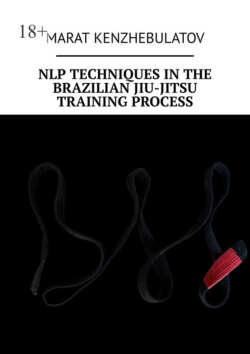Читать книгу NLP techniques in the Brazilian Jiu-Jitsu training process. Study Guide - Марат Кенжебулатов, Marat Kenzhebulatov - Страница 4
Chapter 1.
NLP and training
Оглавление1.1. BJJ and Rapport
The development of modern BJJ is moving forward rapidly. The emergence of new techniques, access to the Internet, universal digitalization, the expansion of experience, which must be transferred as quickly and efficiently as possible in training processes, pose new challenges to BJJ. Everyone around is concerned about effective learning, namely the assimilation of new information. Specialists in this area are engaged, whose task is to find the most effective assimilation. And each BJJ academy is considering new ways to address this; however, there is still no universal solution. Depending on the viewpoint of the academy, the emphasis in the training process is on different approaches.
I want to draw the attention of professors and heads of academies to the use of neurolinguistic programming (NLP) technologies in teaching BJJ. The use of NLP ideas makes it possible to implement both a general and an individual approach to students, which has recently become very popular and practiced. The task is complicated by the fact that it is necessary to identify the leading channel of perception, which, accordingly, will open up opportunities for determining the most effective ways of receiving information for each person. Then it will allow you to create and implement a universal approach to students, taking into account their different representative systems and metaprograms. As a rule, learning has always been associated with mental ability, while limiting only to the distinctness of thinking. We will take into account various processes of the psyche, specifically memory, the speed of decision-making, motivation, etc. To assess the trainees, we will use indicators such as the progress speed, initiative, efficiency, the adaptation speed in new conditions. We are going to focus on the individual characteristics of students – imagination, attention, memory, and thinking.
There is a very important element here, which is, one might say, key in the relationship between students and the Professor. It’s all about rapport.
Rapport is the state of two or more people who enter into mental confidence in one other. Leading another person is a type of influence in which the behavior of one person causes a certain behavior in another. For example, someone on the team begins to actively and confidently behave and sets the tone, and this passes on to the rest of the team. This situation is very effective in team sports competitions.
Where there is rapport, people act as a single mechanism, and everything is interconnected. It’s like a clock. Imagine a stream of cars on a freeway – everyone drives fast, orderly, and trusts each other. Or as a dancing couple, where a full rapport is established between partners, a man leads and a woman completely trusts him! The professor explains the technique, and all students trust him and repeat one to one, honing their skills. People who are in rapport are said to be on the same wavelength.
The creation of rapport is the creation of such a resonance between people, which will be primarily conscious and subject to control when achieving specific goals.
This so-to-say joint voyage will result in trust. Trust is present where people are alike in their ideas, interests, and, of course, in their conduct. Oddly enough, the more people are alike, the more trust there is! After all, a person most of all trusts himself first.
There are various tools to achieve rapport between a professor and their students, but we will learn to adjust to representative systems and metaprograms or teach in a way that takes into account each student’s representative systems and metaprograms. Establishing rapport is the most important component in the BJJ training process!
1.2. Sense organs as ways to perceive information
Have you ever wondered how a person receives, stores, and encodes information entering their brain? It is the representative systems that help him in this. In the scientific world, experts in this field use different definitions of this term – channel of perception, sensory modality.
There are three representative systems in the NLP and three groups of people that are formed according to the degree of predominance in perception:
• visual learners, with a predominant visual system;
• auditory learners, with a predominant auditory system;
• kinesthetic learners, with a predominant kinesthetic system.
Any person receiving information from the outside world uses their senses, which are the so-called stimuli. With their help, the final understanding of what is happening around is formed. Specifically, we are talking about sight, hearing, taste, smell, and tactile sense. All information that a person accepts is systematized. The human brain assigns them its specific code, gives meaning, and displays it already in the form of feelings, emotions, speech, movements, etc. This is how our individual “experience” is formed – a representation of the perceived surrounding world. Inside we have the equivalents of each of these five senses, which add up to a “mirror: system. With the help of these equivalents, we remember, think, and visualize.
As a result, two main goals need to be achieved:
1) draw the student’s attention to the information that is being presented;
